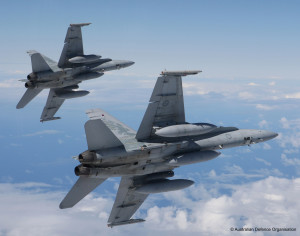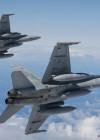World first for the RAAF with ASRAAM

In a world first for an Air Force and an infra-red guided missile, Air Combat Group (ACG) of the Royal Australian Air Force has successfully carried out the first in-service ‘Lock After Launch’ firing of an ASRAAM (Advanced short-range air-to-air missile) at a target located behind the wing-line of the ‘shooter’ aircraft. The firing was conducted from an F/A-18 fighter aircraft, at low level and typical fighter speed, at a target located behind the fighter at a range in excess of 5km. The result was a direct hit on the target.
The engagement simulated a “chase down” situation by an enemy fighter and successfully demonstrated the potential for an all-round self protection capability with the ASRAAM. This capability is inherent on all platforms that provide pre-launch ‘over the shoulder’ designation information such as F/A-18, Eurofighter Typhoon and F-35 JSF.
Commenting on the firing, a representative from Air Combat Group said “this demonstration of ASRAAM capability is a major step forward for the RAAF and greatly increases the lethality of ACG’s F/A-18 fleet. It is a credit to the RAAF-MBDA-DSTO team who worked together to deliver this capability edge to the fleet.”
ASRAAM entered service with the RAAF in July 2004. To provide unique levels of in service support, facilities were established in Adelaide injecting some AUS$20 million into the South Australian economy over a period of 6 years. The facilities are located at the Defence Science & Technology Organisation at Edinburgh (SA) and at BAE Systems at Edinburgh Park. These facilities provide the in-country capability to support the front line equipment.
Having entered service with the Royal Air Force in 2002, and deployed on Tornado, Typhoon, and shortly F-35 JSF, the ASRAAM programme has provided a unique opportunity for information exchange between the respective air forces, government departments and scientific organisations.

L’ACG (Air Combat Group) de l’armée de l’air australienne (RAAF) vient de réaliser une première mondiale, à la fois pour une armée de l’air et pour un missile à guidage infrarouge, en réussissant le premier tir “Lock After Launch” (accrochage après tir) en service d’un missile ASRAAM (Advanced short-range air-to-air missile) sur une cible située dans le secteur arrière de l’avion tireur. Le tir a été effectué depuis un chasseur F/A-18, à basse altitude et à une vitesse représentative, sur une cible située derrière l’avion, à une distance de plus de 5 km. La cible a été atteinte par impact direct.
L’engagement simulait une situation de “chasse” par un chasseur ennemi. Il a permis de démontrer le potentiel d’autodéfense complète que procure l’ASRAAM. Cette capacité est inhérente à toutes les plates-formes qui sont capables de fournir des informations de désignation d’objectif vers l’arrière (“over the shoulder”) avant lancement du missile, telles que le F/A-18, l’Eurofighter Typhoon et le F-35 JSF.
Commentant le tir ainsi effectué, un représentant de l’ACG a déclaré : “cette démonstration de la capacité de l’ASRAAM constitue un grand pas en avant pour la RAAF et accroît considérablement la létalité de la flotte de F/A-18 de l’ACG. Cette réussite revient avant tout à l’équipe RAAF-MBDA-DSTO, qui par son travail en coopération a permis de doter notre flotte de cette haute capacité”.
L’ASRAAM est entré en service dans la RAAF en juillet 2004. Afin de garantir un soutien opérationnel très performant, des installations ont été spécialement mises en place à Adelaide, qui représentent une injection de quelque 20 millions de dollars australiens dans l’économie de la région sud de l’Australie sur six ans. Ces installations sont situées à la Defence Science & Technology Organisation d’Edinburgh (SA) et chez BAE Systems, au Edinburgh Park. Elles apportent la capacité autonome nécessaire pour assurer le soutien des équipements opérationnels.
Entré en service dans la Royal Air Force en 2002, puis déployé sur Tornado, Typhoon, et prochainement sur F-35 JSF, le programme ASRAAM programme constitue un moyen exceptionnel d’échanger des informations entre les armées de l’air, les organes ministériels et les organisations scientifiques concernés.

Die Air Combat Group (ACG) der Royal Australian Air Force hat zum ersten Mal weltweit erfolgreich einen im Dienst befindlichen ASRAAM Flugkörper (Advanced short-range air-to-air missile) mit ‘Lock After Launch’-Funktion auf ein Ziel abgefeuert, das sich mehr als 5km hinter dem F/A-18-Trägerflugzeug befand. Das Ziel wurde direkt getroffen. Das Schießen wurde in geringer Höhe und in einer für das Kampflugzeug typischen Einsatzgeschwindigkeit durchgeführt.
Im Rahmen des Szenarios wurde eine Verfolgung durch ein feindliches Kampfflugzeug simuliert. Damit wurde erfolgreich das ASRAAM-Rundum-Selbstschutz/Selbstverteidigungs-Potential demonstriert. Diese Fähigkeit kommt auf allen Plattformen zum Tragen, die vor dem Abfeuern eines Flugkörpers sogenannte ‘over the shoulder’-Zieldaten liefern – wie beispielsweise die Plattformen Eurofighter Typhoon, F/A-18, und F-35 JSF.
Ein Vertreter der Air Combat Group kommentierte: “Diese Demonstration der Fähigkeit von ASRAAM bedeutet für die RAAF einen großen Fortschritt, der die Schlagkraft der F/A-18-Luftflotte der ACG ganz erheblich verbessert. Dies ist ein Verdienst des RAAF-MBDA-DSTO-Teams, das dank seiner erfolgreichen Zusammenarbeit mit unserer Luftflotte diese besondere Fähigkeit entwickelt hat.”
ASRAAM ist im Juli 2004 von der RAAF in Dienst gestellt worden. Um alle Ebenen des „In-Service-Support“ zu gewährleisten sind entsprechende Einrichtungen in Adelaide errichtet worden. In diesem Zusammenhang sind über einen Zeitraum von 6 Jahren Aufträge im Wert von AUS$20 Millionen an südaustralische Unternehmen vergeben worden. Die Einrichtungen haben ihre Standorte bei der Defence Science & Technology Organisation in Edinburgh (SA) und bei BAE Systems in Edinburgh Park. Diese Einrichtungen bieten die Möglichkeit, die Betreuung der einsatzrelevanten Ausrüstung im eigenen Land durchzuführen.
Das ASRAAM-Programm bietet nach seiner Indienststellung bei der Royal Air Force im Jahr 2002 und seinem Einsatz auf Tornado, Typhoon und F-35 JSF eine einzigartige Gelegenheit zum Informationsaustausches zwischen den betreffenden Luftwaffen, Behörden und wissenschaftlichen Organisationen.

Per la prima volta in assoluto, la RAAF ha lanciato un missile a guida infrarossi, ASRAAM (Advanced Short-Range Air-to-Air Missile). La missione è stata condotta dal gruppo ACG (Air Combat Group) dell’aeronautica australiana RAAF che ha portato a termine con successo il primo lancio in “Lock After Launch” di un missile di questo tipo ASRAAM contro un obiettivo situato dietro la linea di vista dell’ala dell’aereo lanciatore. Il lancio è stato eseguito da un caccia F/A-18, a bassa quota e velocità di caccia standard, contro un obiettivo situato ad oltre 5 km. Il risultato è stato un impatto diretto con il bersaglio.
L’ingaggio ha simulato una situazione di “chase down” (aggancio) da parte di un caccia nemico, dimostrando nel migliore dei modi il potenziale di auto-protezione globale garantito dal missile ASRAAM. Questa funzionalità è integrata su tutte le piattaforme che forniscono informazioni di individuazione “over the shoulder” prima del lancio, quali F/A-18, Eurofighter Typhoon e F-35 JSF.
Commentando il lancio, un rappresentante di ACG ha detto: “Questa dimostrazione delle capacità di ASRAAM rappresenta un grande passo avanti per la RAAF e aumenta notevolmente la letalità della flotta F/A-18 di ACG. Il merito va al team composto da RAAF-MBDA-DSTO, che ha collaborato per fornire questa funzionalità di alto livello alla forza aerea.”
L’ ASRAAM è entrato in servizio con la RAAF nel luglio 2004. Nella città di Adelaide sono state create delle strutture destinate a fornire livelli di supporto in servizio, con un investimento di 20 milioni di AUS$ nell’economia dell’Australia meridionale per un periodo di 6 anni. Tali strutture, situate presso la Defence Science & Technology Organisation di Edinburgh (Australia meridionale) e BAE Systems di Edinburgh Park, garantiscono al paese capacità interne di supporto per le apparecchiature di prima linea.
Il programma ASRAAM, in servizio nella Royal Air Force dal 2002 e utilizzato su Tornado, Typhoon e a breve anche su F-35 JSF, ha rappresentato un’opportunità unica per lo scambio di informazioni tra le rispettive Forze aeree, i dipartimenti governativi e le organizzazioni scientifiche.




